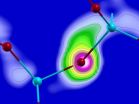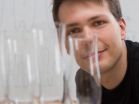(Press-News.org) Quartz glass does not conduct electric current, it is a typical example of an insulator. With ultra-short laser pulses, however, the electronic properties of glass can be fundamentally changed within femtoseconds (1 fs = 10^-15 seconds). If the laser pulse is strong enough, the electrons in the material can move freely. For a brief moment, the quartz glass behaves like metal. It becomes opaque and conducts electricity. This change of material properties happens so quickly that it can be used for ultra-fast light based electronics. Scientists at the Vienna University of Technology (TU Wien) have now managed to explain this effect using large-scale computer simulations.
Watching Small Things on Ultra-Fast Time Scales
In recent years, ultra-short laser pulses of only a few femtoseconds have been used to investigate quantum effects in atoms or molecules. Now they can also be used to change material properties. In an experiment (at the Max-Planck Institute in Garching, Germany) electric current has been measured in quartz glass, while it was illuminated by a laser pulse. After the pulse, the material almost immediately returns to its previous state. Georg Wachter, Christoph Lemell and Professor Joachim Burgdörfer (TU Wien) have now managed to explain this peculiar effect, in collaboration with researchers from the Tsukuba University in Japan.
Quantum mechanically, an electron can occupy different states in a solid material. It can be tightly bound to one particular atom or it can occupy a state of higher energy in which it can move between atoms. This is similar to the behaviour of a little ball on a dented surface: when it has little energy, it remains in one of the dents. If the ball is kicked hard enough, it can move around freely.
"The laser pulse is an extremely strong electric field, which has the power to dramatically change the electronic states in the quartz", says Georg Wachter. "The pulse can not only transfer energy to the electrons, it completely distorts the whole structure of possible electron states in the material."
That way, an electron which used to be bound to an oxygen atom in the quartz glass can suddenly change over to another atom and behave almost like a free electron in a metal. Once the laser pulse has separated electrons from the atoms, the electric field of the pulse can drive the electrons in one direction, so that electric current starts to flow. Extremely strong laser pulses can cause a current that persists for a while, even after the pulse has faded out.
Several Quantum Processes at the Same Time
"Modelling such effects is an extremely complex task, because many quantum processes have to be taken into account simultaneously", says Joachim Burgdörfer. The electronic structure of the material, the laser-electron interaction and also the interactions between the electrons has to be calculated with supercomputers. "In our computer simulations, we can study the time evolution in slow motion and see what is actually happening in the material", says Burgdörfer.
In the transistors we are using today, a large number of charge carriers moves during each switching operation, until a new equilibrium state is reached, and this takes some time. The situation is quite different when the material properties are changed by the laser pulse. Here, the switching process results from the change of the electronic structure and the ionization of atoms. "These effects are among the fastest known processes in solid state physics", says Christoph Lemell. Transistors usually work on a time scale of picoseconds (10^-12 seconds), laser pulses could switch electric currents a thousand times faster.
The calculations show that the crystal structure and chemical bonds in the material have a remarkably big influence on the ultra-fast current. Therefore, experiments with different materials will be carried out to see how the effect can be used even more efficiently.
The results have now been published in the journal Physical Review Letters.
INFORMATION:
Further Information:
Dipl.-Ing. Georg Wachter
Institute for Theoretical Physics
TU Wien
Wiedner Hauptstraße 8-10, 1040 Wien
T: +43-1-58801-13630
georg.wachter@tuwien.ac.at
Prof. Joachim Burgdörfer
Institute for Theoretical Physics
TU Wien
Wiedner Hauptstraße 8-10, 1040 Wien
T: +43-1-58801-13610
joachim.burgdoerfer@tuwien.ac.at
Laser pulse turns glass into a metal
New effect could be used for ultra-fast logical switches
2014-08-26
ELSE PRESS RELEASES FROM THIS DATE:
Study calls into question link between prenatal antidepressant exposure and autism risk
2014-08-26
Previous studies that have suggested an increased risk of autism among children of women who took antidepressants during pregnancy may actually reflect the known increased risk associated with severe maternal depression. In a study receiving advance online publication in Molecular Psychiatry, investigators from Massachusetts General Hospital (MGH) report that – while a diagnosis of autism spectrum disorder was more common in the children of mothers prescribed antidepressants during pregnancy than in those with no prenatal exposure – when the severity of the mother's depression ...
Study: Earth can sustain more terrestrial plant growth than previously thought
2014-08-26
CHAMPAIGN, Ill. — A new analysis suggests the planet can produce much more land-plant biomass – the total material in leaves, stems, roots, fruits, grains and other terrestrial plant parts – than previously thought.
The study, reported in Environmental Science and Technology, recalculates the theoretical limit of terrestrial plant productivity, and finds that it is much higher than many current estimates allow.
"When you try to estimate something over the whole planet, you have to make some simplifying assumptions," said University of Illinois plant biology professor ...
New tool to probe cancer's molecular make-up
2014-08-26
Scientists have shown how to better identify and measure vital molecules that control cell behaviour – paving the way for improved tools for diagnosis, prediction and monitoring of cancer.
Researchers from the Cancer Research UK Manchester Institute based at The University of Manchester – part of the Manchester Cancer Research Centre – and the Institute of Cancer Research, London, looked at protein kinases, molecules that control various aspects of cellular function.
The study, funded by a Biotechnology and Biological Sciences Research Council (BBSRC)/Pfizer CASE studentship ...
Symptoms after breast cancer surgery need to be treated on an individual basis
2014-08-26
For those affected, breast cancer is a dramatic diagnosis. Patients often have to endure chemotherapy and surgery, which, depending on the individual scenario, may mean breast conserving surgery or breast removal—mastectomy. In the aftermath, many women experience symptoms such as pain, fatigue/exhaustion, or sleep disturbances. However, the symptoms are highly individual, as Stefan Feiten and colleagues emphasize in a recent study reported in Deutsches Ärzteblatt International (Dtsch Arztebl Int 2014; 111: 537-44).
The authors state that it is crucial for good aftercare ...
Life in Saxony-Anhalt: More attention should be paid to the heart!
2014-08-26
A lack of education, an unhealthy diet, and unemployment go straight to the heart—quite literally, because all three range among the risks that cause ischemic heart disease or contribute to its development. According to a recent study reported by epidemiologists Andreas und Maximilian Stang in Deutsches Ärzteblatt International (Dtsch Arztebl Int 2014; 111: 530-6), the risk factors for heart disease are higher in Saxony-Anhalt than in all other German states, and more persons die from heart disease in the state.
Many of the risk factors could be treated in a more targeted ...
A high-resolution bedrock map for the Antarctic Peninsula
2014-08-26
26.08.2014: Antarctic glaciers respond sensitively to changes in the Atmosphere/Ocean System. Assessing and projecting the dynamic response of glaciers on the Antarctic Peninsula to changed atmospheric and oceanic forcing requires high-resolution ice thickness data as an essential geometric constraint for ice flow models. Therefore, a Swiss-German team of scientists developed a complete bedrock data set for the Antarctic Peninsula on a 100 m grid. They calculated the spatial distribution of ice thickness based on surface topography and ice dynamic modelling.
Daniel Farinotti, ...
Duality principle is 'safe and sound'
2014-08-26
Decades of experiments have verified the quirky laws of quantum theory again and again. So when scientists in Germany announced in 2012 an apparent violation of a fundamental law of quantum mechanics, a physicist at the University of Rochester was determined to find an explanation.
"You don't destroy the laws of quantum mechanics that easily," said Robert Boyd, professor of optics and of physics at Rochester and the Canada Excellence Research Chair in Quantum Nonlinear Optics at the University of Ottawa.
In their 2012 version of the famous Young two-split experiment, ...
Eye implant developed at Stanford could lead to better glaucoma treatments
2014-08-26
For the 2.2 million Americans battling glaucoma, the main course of action for staving off blindness involves weekly visits to eye specialists who monitor – and control – increasing pressure within the eye.
Now, a tiny eye implant developed at Stanford could enable patients to take more frequent readings from the comfort of home. Daily or hourly measurements of eye pressure could help doctors tailor more effective treatment plans.
Internal optic pressure (IOP) is the main risk factor associated with glaucoma, which is characterized by a continuous loss of specific retina ...
Fibre-based satiety ingredient shown to make you eat less
2014-08-26
Scientists from the University of Liverpool have demonstrated the effectiveness of a fibre-based dietary ingredient that makes people feel less hungry and consume less food.
Hunger is a major barrier to successful weight control and consumers need healthy foods that will help them control their appetite. Although fibres have the potential to modulate appetite without adding additional calories, they can make foods less appealing. Moreover, most studies employing fibres have failed to demonstrate positive effects on either appetite or food intake, and certainly no effects ...
Education and dog-friendly neighbourhoods could tackle obesity
2014-08-26
A study from the University of Liverpool has recommended investing in dog owner education and facilities as a strategy to target physical inactivity and problems such as obesity in both people and their pets.
In a review of scientific papers published since 1990, the researchers found that access to dog-friendly walking environments and better education about dogs' physical needs, could all motivate people to get out and take more exercise with their pets.
It is estimated that 40% of dog owners don't take their dogs for a walk. In the UK, almost a quarter of households ...
LAST 30 PRESS RELEASES:
Do our body clocks influence our risk of dementia?
Anthropologists offer new evidence of bipedalism in long-debated fossil discovery
Safer receipt paper from wood
Dosage-sensitive genes suggest no whole-genome duplications in ancestral angiosperm
First ancient human herpesvirus genomes document their deep history with humans
Why Some Bacteria Survive Antibiotics and How to Stop Them - New study reveals that bacteria can survive antibiotic treatment through two fundamentally different “shutdown modes”
UCLA study links scar healing to dangerous placenta condition
CHANGE-seq-BE finds off-target changes in the genome from base editors
The Journal of Nuclear Medicine Ahead-of-Print Tip Sheet: January 2, 2026
Delayed or absent first dose of measles, mumps, and rubella vaccination
Trends in US preterm birth rates by household income and race and ethnicity
Study identifies potential biomarker linked to progression and brain inflammation in multiple sclerosis
Many mothers in Norway do not show up for postnatal check-ups
Researchers want to find out why quick clay is so unstable
Superradiant spins show teamwork at the quantum scale
Cleveland Clinic Research links tumor bacteria to immunotherapy resistance in head and neck cancer
First Editorial of 2026: Resisting AI slop
Joint ground- and space-based observations reveal Saturn-mass rogue planet
Inheritable genetic variant offers protection against blood cancer risk and progression
Pigs settled Pacific islands alongside early human voyagers
A Coral reef’s daily pulse reshapes microbes in surrounding waters
EAST Tokamak experiments exceed plasma density limit, offering new approach to fusion ignition
Groundbreaking discovery reveals Africa’s oldest cremation pyre and complex ritual practices
First breathing ‘lung-on-chip’ developed using genetically identical cells
How people moved pigs across the Pacific
Interaction of climate change and human activity and its impact on plant diversity in Qinghai-Tibet plateau
From addressing uncertainty to national strategy: an interpretation of Professor Lim Siong Guan’s views
Clinical trials on AI language model use in digestive healthcare
Scientists improve robotic visual–inertial trajectory localization accuracy using cross-modal interaction and selection techniques
Correlation between cancer cachexia and immune-related adverse events in HCC
[Press-News.org] Laser pulse turns glass into a metalNew effect could be used for ultra-fast logical switches



